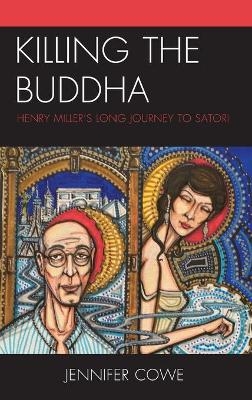
Killing the Buddha
Henry Miller’s Long Journey to Satori
Seiten
2020
Fairleigh Dickinson University Press (Verlag)
978-1-68393-041-9 (ISBN)
Fairleigh Dickinson University Press (Verlag)
978-1-68393-041-9 (ISBN)
Killing the Buddha examines the influence of Zen Buddhism throughout Henry Miller's life and work, specifically charting the evolution of key Buddhist concepts through close readings of his novels, letters and pamphlets.
Incorporating the novels, pamphlets and letters of Henry Miller, Killing the Buddha argues for Miller’s written work to be considered as a whole in relation to the theme of Zen Buddhism, specifically the concept of Satori (awakening). By reading Miller’s literary output and letters as a spiritual journey to awakening, it is possible to chart his development as a writer, and offer insight into his repetitive use of biographical material. Reflecting upon the influence of Otto Rank and Henri Bergson on Miller’s conceptualization of the role of the writer, and then by examining his complex rejection of Surrealism, it is possible to show Miller’s burgeoning Zen Buddhism as a life-long quest for acceptance and authenticity explicitly explored within his work. With close readings of the ‘Obelisk Trilogy’ of the 1930s (Tropic of Cancer, Tropic of Capricorn and Black Spring) and The Rosy Crucifixion Trilogy (1949-1960), Miller’s complex journey to Satori is shown as a continuous progression from his early notorious novels through to the essays and pamphlets of his later career.
Incorporating the novels, pamphlets and letters of Henry Miller, Killing the Buddha argues for Miller’s written work to be considered as a whole in relation to the theme of Zen Buddhism, specifically the concept of Satori (awakening). By reading Miller’s literary output and letters as a spiritual journey to awakening, it is possible to chart his development as a writer, and offer insight into his repetitive use of biographical material. Reflecting upon the influence of Otto Rank and Henri Bergson on Miller’s conceptualization of the role of the writer, and then by examining his complex rejection of Surrealism, it is possible to show Miller’s burgeoning Zen Buddhism as a life-long quest for acceptance and authenticity explicitly explored within his work. With close readings of the ‘Obelisk Trilogy’ of the 1930s (Tropic of Cancer, Tropic of Capricorn and Black Spring) and The Rosy Crucifixion Trilogy (1949-1960), Miller’s complex journey to Satori is shown as a continuous progression from his early notorious novels through to the essays and pamphlets of his later career.
Jennifer Cowe is lecturer in the School of Journalism, Writing, and Media at the University of British Columbia.
Introduction
Chapter One: I am an Artist: Henry Miller and Otto Rank
Chapter Two: The Art of Becoming: Henry Miller and Henri Bergson
Chapter Three: Refusing the Automatic Message: Henry Miller and Surrealism
Chapter Four: Killing the Buddha: Miller and Zen Buddhism
Conclusion
References
Index
About the Author
| Erscheinungsdatum | 10.05.2021 |
|---|---|
| Verlagsort | Cranbury |
| Sprache | englisch |
| Maße | 161 x 229 mm |
| Gewicht | 358 g |
| Themenwelt | Geisteswissenschaften ► Religion / Theologie ► Buddhismus |
| Geisteswissenschaften ► Sprach- / Literaturwissenschaft ► Anglistik / Amerikanistik | |
| Geisteswissenschaften ► Sprach- / Literaturwissenschaft ► Literaturwissenschaft | |
| ISBN-10 | 1-68393-041-X / 168393041X |
| ISBN-13 | 978-1-68393-041-9 / 9781683930419 |
| Zustand | Neuware |
| Informationen gemäß Produktsicherheitsverordnung (GPSR) | |
| Haben Sie eine Frage zum Produkt? |
Mehr entdecken
aus dem Bereich
aus dem Bereich
Unterweisungen in Zen-Meditation
Buch | Hardcover (2024)
Arkana (Verlag)
CHF 29,90


